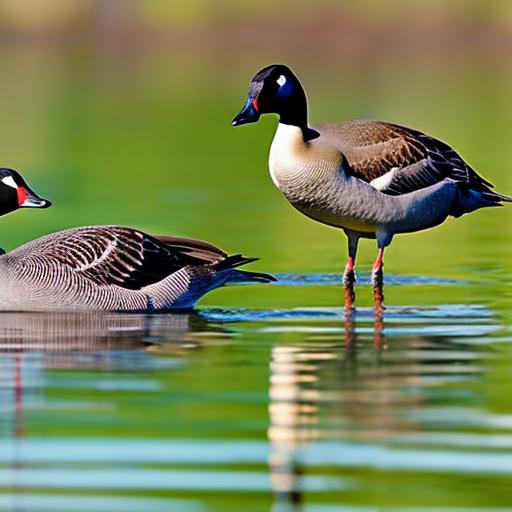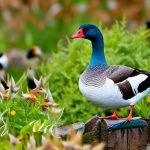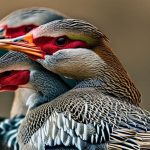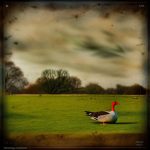Canada geese are a common sight in many parts of North America, and their behavior can sometimes cause problems for humans. From their loud honking to their droppings, Canada geese can be a nuisance in parks, golf courses, and other public spaces. It is important to manage Canada geese populations in order to maintain a balance between humans and wildlife. In this article, we will explore the behavior of Canada geese, natural deterrents, creating a goose-free environment, effective repellents, preventing nesting, managing geese in urban areas, humane ways to keep them away, professional services for control, legal considerations, and tips for long-term prevention.
Key Takeaways
- Canada geese are social birds that mate for life and are highly protective of their young.
- Natural deterrents for Canada geese include planting tall grasses, using decoys, and installing barriers.
- Creating a goose-free environment involves removing food sources, reducing water access, and using noise deterrents.
- Effective repellents for Canada geese include chemical sprays, sound devices, and visual deterrents.
- Preventing Canada geese from nesting on your property involves removing nests and eggs, and using nest deterrents.
Understanding the Behavior of Canada Geese
Canada geese are highly adaptable birds that can be found in a variety of habitats, from urban areas to rural wetlands. They are attracted to areas with open water, abundant food sources, and suitable nesting sites. Canada geese are social animals that travel in large flocks and communicate with each other through honking. They are also known for their aggressive behavior when defending their territory or young.
To identify Canada geese behavior, look for their distinctive V-shaped flight pattern and their loud honking calls. They are often seen grazing on grassy areas or swimming in bodies of water. During the breeding season, they may become more territorial and aggressive towards humans or other animals that come too close to their nests.
Natural Deterrents for Canada Geese
There are several natural deterrents that can be used to keep Canada geese away from certain areas. One effective method is landscaping with plants that are unattractive to geese. For example, planting tall grasses or shrubs along the water’s edge can create a barrier that discourages geese from landing or nesting.
Habitat modification is another natural deterrent that can be used to make an area less attractive to Canada geese. This can include removing or reducing open water sources, such as ponds or lakes, that geese are attracted to. Additionally, reducing the availability of food sources, such as grass or crops, can help discourage geese from frequenting an area.
Creating a Goose-Free Environment
Creating a goose-free environment requires a combination of strategies to make an area less attractive to Canada geese. One important step is to remove or reduce potential nesting sites. This can involve removing tall grasses or shrubs where geese may build their nests. It is also important to regularly clean up any food sources, such as spilled birdseed or garbage, that may attract geese.
Another strategy is to install physical barriers, such as fences or netting, to prevent geese from accessing certain areas. These barriers should be at least three feet high and extend into the water to prevent geese from walking around them. Additionally, using reflective materials or scare devices, such as balloons or flags, can help deter geese from landing or nesting in an area.
Effective Repellents for Canada Geese
In addition to natural deterrents, there are several effective repellents that can be used to keep Canada geese away. One option is the use of sound devices that emit loud noises or predator calls. These devices can startle geese and make them feel unsafe, causing them to leave the area.
Visual deterrents can also be effective in deterring Canada geese. These can include decoys of predators, such as coyotes or owls, that geese perceive as a threat. Additionally, using reflective materials, such as Mylar tape or scare-eye balloons, can create a visual deterrent that makes geese uncomfortable.
Preventing Canada Geese from Nesting on Your Property
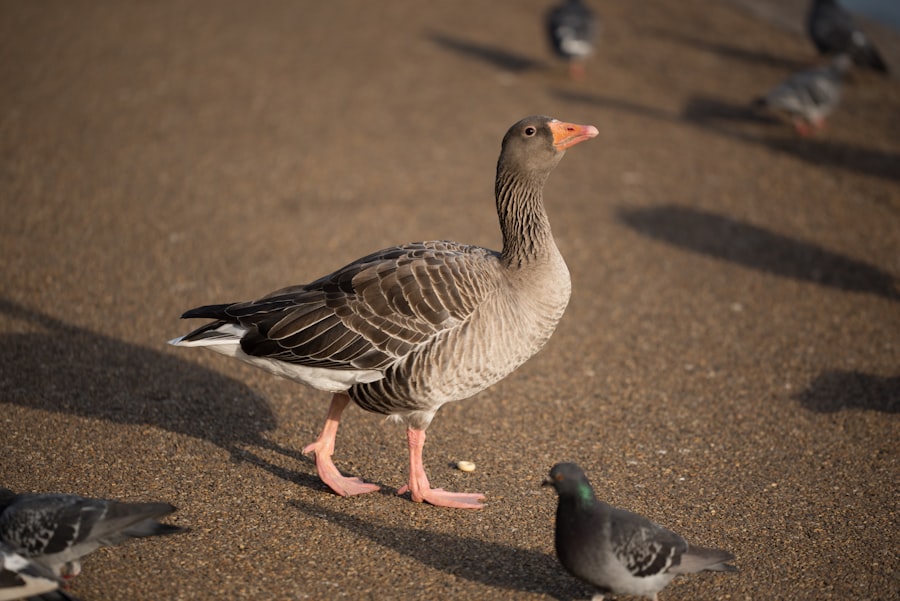
Preventing Canada geese from nesting on your property requires identifying potential nesting areas and taking steps to discourage nesting. Geese typically build their nests on the ground near water, so it is important to remove or modify any areas that may be attractive to them.
To discourage nesting, regularly mow grassy areas to keep them short and less suitable for nesting. Removing or reducing vegetation near water’s edge can also make an area less attractive to geese. Additionally, using visual deterrents, such as predator decoys or reflective materials, can help deter geese from nesting in an area.
Managing Canada Geese in Urban Areas
Managing Canada geese in urban areas requires a combination of strategies to minimize conflicts between geese and humans. One important step is to identify areas where geese are likely to be found, such as parks, golf courses, or residential neighborhoods near water sources.
To manage geese in urban areas, it is important to implement a combination of natural deterrents, creating a goose-free environment, and effective repellents. This can include landscaping with plants that are unattractive to geese, removing or reducing open water sources, installing physical barriers, and using sound devices or visual deterrents.
Humane Ways to Keep Canada Geese Away
When it comes to keeping Canada geese away, it is important to prioritize humane methods that do not harm the birds or other wildlife. Habitat modification is one effective and humane method that can be used to make an area less attractive to geese. This can include removing or reducing open water sources and food sources.
Relocation is another humane method that can be used to manage Canada geese populations. This involves capturing and relocating geese to a more suitable habitat where they are less likely to cause conflicts with humans. It is important to work with trained professionals who have experience in safely capturing and relocating geese.
Professional Services for Canada Geese Control
For those who are unable to manage Canada geese on their own, there are professional services available for geese control. These services can provide expertise in habitat management, population control, and other strategies to effectively manage geese populations.
Habitat management involves modifying the environment to make it less attractive to geese. This can include removing or reducing open water sources, installing physical barriers, and implementing other deterrents. Population control methods can include egg addling or oiling, which involves preventing eggs from hatching or rendering them non-viable.
Legal Considerations for Managing Canada Geese
When managing Canada geese, it is important to be aware of the legal considerations and regulations that govern their management. Canada geese are protected under the Migratory Bird Treaty Act, which prohibits the capture, killing, or possession of migratory birds without a permit.
However, there are exceptions to this law that allow for the management of Canada geese in certain situations. These exceptions vary by state and may require permits or authorization from wildlife agencies. It is important to consult with local authorities or wildlife agencies to ensure compliance with applicable laws and regulations.
Tips for Long-Term Goose Prevention
To maintain a goose-free environment in the long term, it is important to regularly monitor and implement strategies to deter geese from returning. This can include regularly cleaning up food sources, maintaining physical barriers, and using sound devices or visual deterrents as needed.
Regularly monitoring nesting areas and taking steps to discourage nesting can also help prevent geese from returning. By consistently implementing these strategies, you can create an environment that is less attractive to Canada geese and minimize conflicts with humans.
Managing Canada geese populations is important for maintaining a balance between humans and wildlife. By understanding their behavior and implementing effective deterrents, it is possible to create a goose-free environment that minimizes conflicts with humans. Whether through natural deterrents, effective repellents, or professional services, there are a variety of strategies available to manage Canada geese in a humane and effective manner. By taking action to manage Canada geese in your area, you can help create a more harmonious coexistence between humans and wildlife.
If you’re looking for effective ways to keep Canada geese away, you might find this article on poultrywizard.com helpful. It provides valuable insights on how many eggs geese lay and offers tips on breeding geese. Understanding their reproductive patterns can help you devise strategies to deter them from your property. Check out the article here: https://poultrywizard.com/breeding-geese/how-many-eggs-do-geese-lay/. While you’re at it, poultrywizard.com also offers other useful resources such as ideas for large chicken coops (https://poultrywizard.com/keeping-chickens/large-chicken-coop-ideas/) and even the option to rent a chicken coop (https://poultrywizard.com/keeping-chickens/rent-a-chicken-coop/). Happy reading and good luck with your goose-deterrence efforts!
FAQs
What are Canada Geese?
Canada Geese are a species of waterfowl that are native to North America. They are known for their distinctive black heads and necks, white cheeks, and brown bodies.
Why do Canada Geese need to be kept away?
Canada Geese can cause damage to property, create health hazards, and be a nuisance to people. They can also be aggressive during nesting season and pose a threat to small children and pets.
What are some methods for keeping Canada Geese away?
Some methods for keeping Canada Geese away include using visual deterrents such as scarecrows or reflective tape, using noise deterrents such as loud noises or predator calls, and using physical barriers such as fences or netting.
Is it legal to harm Canada Geese?
No, it is illegal to harm Canada Geese or their nests without a permit from the U.S. Fish and Wildlife Service. It is also illegal to disturb their eggs or young.
What should I do if I encounter an aggressive Canada Goose?
If you encounter an aggressive Canada Goose, it is best to slowly back away and give the bird plenty of space. Do not approach or try to feed the bird, as this can make the situation worse. If the bird continues to be aggressive, contact your local wildlife agency for assistance.
Meet Walter, the feathered-friend fanatic of Florida! Nestled in the sunshine state, Walter struts through life with his feathered companions, clucking his way to happiness. With a coop that’s fancier than a five-star hotel, he’s the Don Juan of the chicken world. When he’s not teaching his hens to do the cha-cha, you’ll find him in a heated debate with his prized rooster, Sir Clucks-a-Lot. Walter’s poultry passion is no yolk; he’s the sunny-side-up guy you never knew you needed in your flock of friends!

